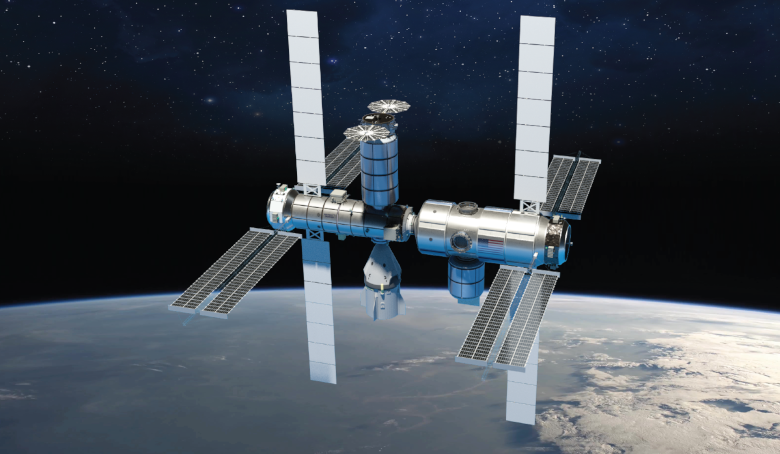NASA has signed agreements with Blue Origin, Nanoracks and Northrop Grumman to design commercially owned and operated space stations in low Earth orbit (LEO) to replace the International Space Station (ISS), the space agency said in an announcement yesterday.
The contracts, worth a total amount of $415.6 million, are a first step in a two-phase process. The first, expected to continue through 2025, is for developing and designing low-Earth orbit destination capabilities suitable for potential government and private sector needs.
Phase two of the awards will involve NASA certifying the designs with the expectation the new facilities will be operational prior to 2030. This will allow a seamless transition from an ageing ISS, that is likely to be retired around the end of the decade.
The US space agency is increasingly turning to private contractors such as SpaceX, who has been selected to deliver cargo to the ISS, as well as build NASA’s Human Landing System as part of its Artemis Programme, in order to reduce costs. This not only benefits NASA but also brings the technology to market for both government and commercial applications.
“With commercial companies now providing transportation to low-Earth orbit in place, we are partnering with US companies to develop the space destinations where people can visit, live, and work, enabling NASA to continue forging a path in space for the benefit of humanity while fostering commercial activity in space,” said NASA Administrator Bill Nelson.
The recipient of a $130 million award, Blue Origin has already partnered up with Sierra Space to develop Orbital Reef, a commercially owned and operated space station to be built in low-Earth orbit.
With plans to start operating in the second half of this decade, Orbital Reef is designed to be a mixed-use space station in low Earth orbit for commerce, research, and tourism.
“Blue Origin and Sierra Space are proud to be awarded the NASA Commercial Destination Free Flyer program,” said Tom Vice, CEO of Sierra Space. “Blue Origin and Sierra Space are committed to the realisation of our vision of enabling humanity to build civilizations in space while enhancing life here on Earth. The commercialisation of low Earth orbit is an important first step in this journey. We look forward to working with NASA on this important program that will advance humanity’s settlement of space.”
Like Blue Origin, Nanoracks has also announced it is developing a free flying commercial space station. Known as Starlab, the station is being built in collaboration with Voyager Space and Lockheed Martin and will deploy from one single launch in 2027.
“To receive this support from NASA validates over a decade of Nanoracks’ hard work forging commercial access to space, bringing over 1300 commercial payloads from 30 nations to the ISS,” said Dr. Amela Wilson, CEO at Nanoracks. “This opportunity opens far-reaching possibilities for critical research and commercial industrial activity in LEO. We are honoured to be selected as one of three awardees to work with NASA, and we cannot wait to bring our existing global commercial customer base to Starlab.”
Northrop Grumman’s design for a modular, commercial destination in low-Earth orbit will also provide a base module for extended capabilities including science, tourism, and industrial experimentation.
The as yet-unnamed station is a modular concept leveraging their Cygnus module, which is already in use as one of the two ISS commercial cargo vehicles and is being adapted for the Habitation and Logistics Outpost (HALO) for NASA’s lunar Gateway space station.
It will have the ability to support four permanent crew members initially, with plans to expand to an eight-person crew and further capability beyond that. The station is designed for a permanent presence of 15 years.
“Our station will enable a smooth transition from International Space Station-based LEO missions to sustainable commercial-based missions where NASA does not bear all the costs, but serves as one of many customers,” said Steve Krein, vice president, civil and commercial space, Northrop Grumman.
The company has also been won a booster production and operations contract by NASA valued up to $3.19 billion to support the Space Launch System (SLS) rocket through 2031. The award includes follow-on production and flight sets for Artemis IV through Artemis VIII, as well as production of the Booster Obsolescence and Life Extension (BOLE) boosters for Artemis IX.
“BOLE leverages our previous investments and existing infrastructures in SLS and supports long-term sustainability of NASA’s exploration programs,” said Wendy Williams, vice president, propulsion systems, Northrop Grumman. “This new booster design will provide additional heavy lift performance and support greater payload volume for deep space human and science missions.”
These three awards are in addition to an existing $140 million contract NASA signed with Axiom Space in January 2020. The two recently completed the preliminary design review of two modules as well as the critical design review of the module’s primary structure.











